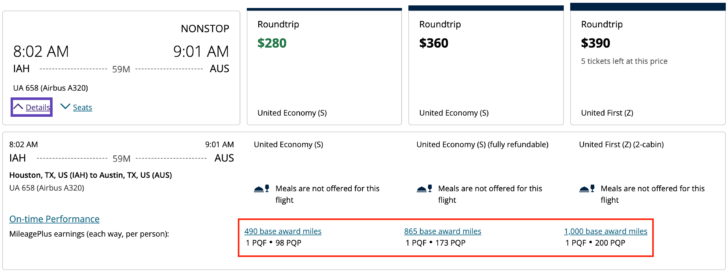United Airlines was my favorite carrier for many years, and I kept my Premier 1K status until finally deciding to switch to Alaska Airlines. The airline is a good middle-of-the-road option. I always liked it for the redemption opportunities available in the Star Alliance. It also helped that as someone originally based in San Francisco, and later Seattle, United had a larger presence than either American or Delta.
United MileagePlus was the first to follow Delta down the revenue-based rabbit hole. I say this because Delta still tracks elite qualifying miles but was the first to make a clean break and stop publishing an award chart. Meanwhile, United doesn’t track miles at all. You’ll earn Premier Qualifying Points and Segments, along with Premier Qualifying Dollars that track how much you spend. It was one step further than Delta was willing to go.
There are still some good redemption opportunities on United even with these changes. But I usually point to them and American Airlines whenever someone needs evidence that earning status has become a little too complicated.
How to Earn Qualifying Points and Segments
A couple years back United stopped tracking elite qualifying miles and switched to Premier Qualifying Points and Premier Qualifying Flights. PQFs are fairly straightforward and represent the number of individual flight segments you travel. If you have a round-trip flight, that’s two segments. If you make a connection each way, that’s four take offs and landings for a total of four segments.
Once you get past PQFs, however, things get complicated.
Premier Qualifying Points are based on the cost of the ticket (base fare and surcharges, excluding some taxes and fees). You’ll also earn PQPs on upgrades and preferred seating in coach. These accrue at a rate of 1 PQP per dollar. So if you book a $300 ticket that includes $20 of taxes and fees, you’ll earn 280 PQPs. United displays the number of PQPs you’ll earn during the booking process.
While it’s true you can earn PQPs on partner carriers, the amount is capped. For most MileagePlus partners, you can earn a maximum of 500 PQPs in economy and premium economy class or 1,000 PQPs in first and business class. Certain airlines are “Preferred Partners” and earn a maximum of 750 or 1,500 PQPs, respectively.
Finally, you can also earn PQPs with a United co-branded credit card. For 2022 cardmembers can earn 500 PQPs for each $12,000 spent. This isn’t a lot, so I don’t recommend you rely heavily on this approach, but it could be helpful if you’re still not traveling as much as you used to pre-pandemic.
Qualification Criteria for Elite Status
You can qualify for elite status using just Premier Qualifying Points or you can use a mix of Premier Qualifying Points and Premier Qualifying Flights. When you rely entirely on PQPs the threshold is higher, so try to boost the number of flights you take if you can.
| PQPs + PQFs | PQPs Only | United Segments | |
|---|---|---|---|
| Premier Silver | 3,000 PQP + 8 PQF | 3,500 | 4 |
| Premier Gold | 6,000 PQP + 16 PQF | 7,000 | 4 |
| Premier Platinum | 9,000 PQP + 24 PQF | 10,000 | 4 |
| Premier 1K | 13,500 PQP + 36 PQF | 15,000 | 4 |
You’ll also need to complete at least four flights marketed and operated by United Airlines (with a UA flight number and United’s logo on the side). This requirement applies to every status tier.
Always remember to include your United Airlines loyalty number in your reservation if you want to earn credit for your travel. You can confirm this by reading your ticket details on confirmation online. It’s difficult to get credit if you use a different airline’s loyalty number by mistake. As a last resort, get it fixed when you check in for your flight or at the gate.
Benefits of United MileagePlus Elite Status
United’s benefits are consistent with those at Delta Air Lines and American Airlines. I’m particularly pleased by the use of Plus Points to allow more flexible upgrade options, which I’ll discuss at the end.
Premier Silver Benefits
- 40% bonus (7 miles per dollar) on flights
- 1 free checked bag
- Discounted CLEAR membership
- Complimentary upgrades to first class 24 hours before departure
- Complimentary preferred seating at booking and Economy Plus at check-in
- Instant upgrades on Y and B fares at booking
Premier Gold Benefits
- 60% bonus (8 miles per dollar) on flights
- 2 free checked bags
- Discounted CLEAR membership
- Complimentary upgrades to first class 48 hours before departure
- Complimentary preferred seating and Economy Plus at booking
- Instant upgrades on Y and B fares at booking
- Marriott Bonvoy Gold status
Premier Platinum Benefits
- 80% bonus (9 miles per dollar) on flights
- 3 free checked bags
- 40 Plus Points
- Discounted CLEAR membership
- Discounted United Club membership
- Complimentary upgrades to first class 72 hours before departure
- Complimentary preferred seating and Economy Plus at booking
- Instant upgrades on Y and B fares at booking
- Marriott Bonvoy Gold status
Premier 1K Benefits
- 120% bonus (11 miles per dollar) on flights
- 3 free checked bags
- 280 additional Plus Points
- Complimentary CLEAR membership
- Discounted United Club membership
- Complimentary upgrades to first class 96 hours before departure
- Complimentary preferred seating and Economy Plus at booking
- Complimentary snack and drink in economy class
- Instant upgrades on Y, B, and M fares at booking
- Marriott Bonvoy Gold status
More about Plus Points
Rather than issue upgrade certificates or awards, United provides its elite members with Plus Points. These are a sort of mileage currency on their own. You can redeem frequent flyer miles for a free flight, and you can redeem Plus Points for an upgrade to business or first class.
For example, a short flight might cost 20 Plus Points to move from economy to first class. An international flight might cost between 30 and 80 Plus Points to move up to business class, depending on what fare you originally booked. Plus Points can also be redeemed on certain flights operated by ANA, Lufthansa, and Copa.






